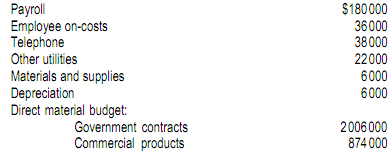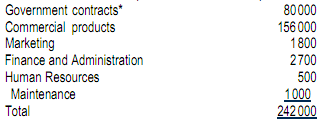Activity-based costing
East Coast Marine Ltd (ECM) manufactures parts for small marine craft. Over the past decade, ECM's management has met its goal of reducing its reliance on government contract work to 50 per cent of total sales. ECM is now equally reliant on commercial sales and government contracts.
Traditionally, the costs of the Material Handling Department have been allocated to direct material as a percentage of direct material dollar value. This was adequate when the majority of the manufacturing was homogeneous and related to government contracts. Recently, however, government auditors have rejected some proposals, stating that ‘the amount of Material Handling Department costs allocated to these proposals is disproportionate to the total effort involved'.
Eloise Smith, the newly hired cost accounting manager, was asked by the manager of ECM's Government Contracts Unit, Paul Jones, to find a more equitable method of allocating the Material Handling Department costs to the user departments. Her review has revealed the following information:
- The majority of the direct material purchases for government contracts are high-dollar, low-volume purchases, while commercial materials represent low- dollar, high-volume purchases.
- Administrative departments such as Marketing, Finance and Administration, Human Resources and Maintenance also use the services of the Material Handling Department on a limited basis but have never been charged in the past for material handling costs.
- One purchasing manager with a direct phone line is assigned exclusively to purchasing high-dollar, low-volume material for government contracts on an annual salary of $36 000. Employee on-costs are estimated to be 20 per cent of the annual salary. The annual costs of the dedicated phone line are $2800.
- The components of the Material Handling Department's budget for the coming year, as proposed by Lindley's predecessor, follow.

Smith has estimated the number of purchase orders to be processed in the coming year as follows:

* Exclusive of high-dollar, low-volume materials.
Smith has recommended to Jones that material handling costs should be allocated on a per purchase order basis. Jones realises that the company has been allocating to government contracts more material handling costs than can be justified. However, the implication of Smith's analysis could be a decrease in his unit's earnings and, consequently, a cut in his annual bonus. Jones told Smith to ‘adjust' her numbers and modify her recommendation so that the results will be more favourable to the Government Contracts Unit.
Being new in her position, Smith is not sure how to proceed. She feels ambivalent about Jones' instructions and suspects his motivation may not be in the best interest of ECM. To complicate matters for Smith, the company's new managing director has asked her to prepare a three-year forecast of the Government Contracts Unit's results, and she believes that the newly recommended allocation method would provide the most accurate data. However, this would put her in direct opposition to Jones' directives.
Smith has assembled the following data to project the material handling costs over the next three years:
- The number of purchase orders increases 5 per cent per year.
- The ratio of government purchase orders to total purchase orders remains at 33 per cent.
- Total direct material costs increase 2.5 per cent per year.
- Material handling costs remain the same percentage of direct material costs.
- Direct government costs (payroll, employee on-costs, and direct phone line) remain constant.
- In addition, she has assumed that the cost of government material in the future will be 70 per cent of total material.
Required:
1 Calculate the material handling rate that would have been used by Eloise Smith's predecessor at East Coast Marine.
2 Calculate the revised material handling costs to be allocated on a per purchase order basis.
3 Discuss why purchase orders might be a more reliable cost driver than the dollar amount of direct material.
4 Calculate the difference due to the change to the new method of allocating material handling costs to government contracts.
5 Prepare a forecast of the cumulative dollar impact over a three-year period (based on the coming year plus 2 more years) of Eloise Smith's recommended change for allocating Material Handling Department costs to the Government Contracts Unit. Round all calculations to the nearest whole number.
6 Referring to the standards of ethical conduct for accountants described in Chapter 1:
(a) Discuss why Eloise Smith has an ethical conflict.
(b) Identify several steps that Smith could take to resolve the ethical conflict.